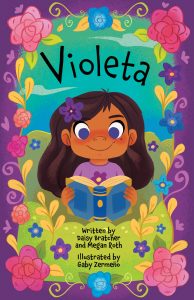Windows offer new views, while mirrors offer reflections. This metaphor is the heart of the Windows and Mirrors learning framework, which recognizes the importance of both perspectives. When planning lessons or choosing books for your classroom library, it’s important to include stories that both reflect the experiences of your students and provide them with insights into the experiences of others.
By understanding this learning theory, you can create a curriculum that serves the needs of all students. Incorporating both points of view grows a child’s sense of belonging and understanding of the world.
Read on to learn more about how stories that act as both windows and mirrors can enrich the learning experiences of children in your classroom. As you will see, Waterford’s commitment to diversity, equity, and inclusion shows in our use of Windows and Mirrors in our curriculum content and design.
Why Windows and Mirrors?
 There has been a belief that it is better to concentrate more on what your students have in common than how they are different. While this can be more comfortable for the teacher, it leaves many students left out. It is essential to portray the diversity of experiences and backgrounds of your students to foster a sense of belonging and caring for others.[1]
There has been a belief that it is better to concentrate more on what your students have in common than how they are different. While this can be more comfortable for the teacher, it leaves many students left out. It is essential to portray the diversity of experiences and backgrounds of your students to foster a sense of belonging and caring for others.[1]
Educator Emily Style created the Windows and Mirrors concept as a framework for building an inclusive curriculum. Her essay on the concept, “Curriculum as Window and Mirror” was published in the Oak Knoll School Monograph in 1988.[2] Style proposes that students need two types of representation in curriculum: stories in which they learn about others (windows) and stories in which they can see themselves (mirrors).
Windows Are Stories About Seeing Others
Windows are stories about life from a different perspective than the reader knows. These lessons and stories allow students to think about life through another person’s eyes, as if looking through a window. Children gain a better understanding of the diversity of human experience and the world around them when they read these kinds of stories.[3]
Stories that act as windows provide students with a deeper understanding of what it is like to be another person. Reading has been shown to increase empathy, which makes these windows to the world stories powerful choices in your curriculum.[4]
Mirrors Are Stories About Seeing Ourselves
 When stories act as mirrors, children see themselves positively reflected. This gives a sense of connection to your curriculum as well as belonging to your school community.[4] You can carry that into lesson plans, activities, and books in the classroom library.
When stories act as mirrors, children see themselves positively reflected. This gives a sense of connection to your curriculum as well as belonging to your school community.[4] You can carry that into lesson plans, activities, and books in the classroom library.
Readers look for people like themselves in stories, and they feel affirmed when they find them.[5] Stories that serve as mirrors help students understand how their experiences relate to concepts you teach. Pay attention to diversity in your school and make sure that your curriculum provides mirrors for every learner.
Windows and Mirrors are both essential for a student’s growth and well-being as a learner. Offering only mirrors can inhibit a student’s empathy and understanding of the world around them, while offering only windows can lead students to feel excluded and that their perspective does not matter.[6]
Windows and Mirrors in Waterford Curriculum
 Waterford uses the Windows and Mirrors framework to guide our early learning curriculum. The Waterford curriculum team designs and updates content to reflect the diversity of the learners served. Using in-depth research on best practices, partner feedback, and regular audits is key to that.
Waterford uses the Windows and Mirrors framework to guide our early learning curriculum. The Waterford curriculum team designs and updates content to reflect the diversity of the learners served. Using in-depth research on best practices, partner feedback, and regular audits is key to that.
Waterford recently created the Sing Around the World series. This set of songs teaches children letter recognition and includes music from different cultural traditions. Each song is sung in English and the culture’s native language. Waterford sought feedback to make sure each song is accurate to its native culture.
To better reflect the lived experiences of diverse learners, a new Waterford chapter book was published: Violeta by Daisy Bratcher. Violeta is based on Daisy’s experiences, from her childhood to when she and her children moved from Mexico to the United States.
You can watch the full Sing Along the World series here. Violeta is available in English and Spanish. To learn more about how the Windows and Mirrors framework informs Waterford’s curriculum, click here for a full report.
Sources:
1. Style, E. “Curriculum As Window and Mirror.” Listening for All Voices. 1988. https://nationalseedproject.org/Key-SEED-Texts/curriculum-as-window-and-mirror
2. Maparyan, L. “On the 30th Anniversary of Emily Style’s “Curriculum as Window and Mirror.” Wellesley Centers for Women. October 5, 2018. https://www.wcwonline.org/WCW-Blog-Women-Change-Worlds/On-the-30th-anniversary-of-emily-style-s-curriculum-as-window-and-mirror.
3. Waterford.org. “Windows and Mirrors: Curriculum that Honors All Learners.” 2022.
4. Kawi, T. “The Importance of Windows and Mirrors in Stories.” PBS Kids. November 5, 2020. https://www.pbs.org/education/blog/the-importance-of-windows-and-mirrors-in-stories.
5. GLSEN Staff. “Developing LGBTQ-Inclusive Classroom Resources.” https://www.glsen.org/activity/inclusive-curriculum-guide.
6. Avery, C. “Windows and Mirrors: Creating Reflective and Inclusive Classrooms.” SEED New Leaders’ Week. 2013. https://www.wscaweb.org/wp-content/uploads/2020/02/4a6b8861507cd1539be04870862d9523.pdf

